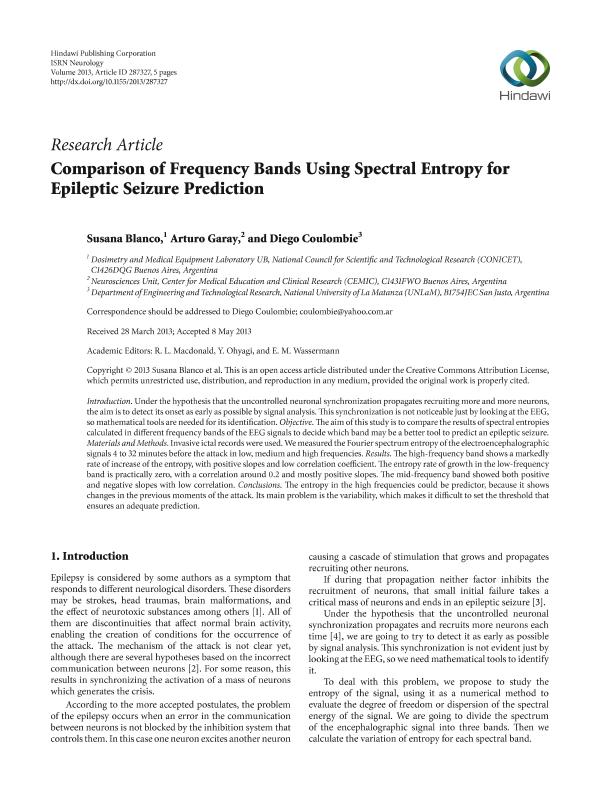Mostrar el registro sencillo del ítem
dc.contributor.author
Blanco, Susana Alicia Ana

dc.contributor.author
Garay, Arturo
dc.contributor.author
Coulombie, Diego
dc.date.available
2016-01-22T20:05:20Z
dc.date.issued
2013-05
dc.identifier.citation
Blanco, Susana Alicia Ana; Garay, Arturo; Coulombie, Diego; Comparison of Frequency Bands Using Spectral Entropy for Epileptic Seizure Prediction; Hindawi Publishing Corporation; ISRN Neurology; 2013; 5-2013; 287327-287327
dc.identifier.issn
2090-5505
dc.identifier.uri
http://hdl.handle.net/11336/3764
dc.description.abstract
Under the hypothesis that the uncontrolled neuronal synchronization propagates recruiting more and more neurons, the aim is to detect its onset as early as possible by signal analysis. This synchronization is not noticeable just by looking at the EEG, so mathematical tools are needed for its identification. Objective. The aim of this study is to compare the results of spectral entropies calculated in different frequency bands of the EEG signals to decide which band may be a better tool to predict an epileptic seizure. Materials and Methods. Invasive ictal records were used. We measured the Fourier spectrum entropy of the electroencephalographic signals 4 to 32 minutes before the attack in low, medium and high frequencies. Results. The high-frequency band shows a markedly rate of increase of the entropy, with positive slopes and low correlation coefficient. The entropy rate of growth in the low-frequency band is practically zero, with a correlation around 0.2 and mostly positive slopes. The mid-frequency band showed both positive and negative slopes with low correlation. Conclusions. The entropy in the high frequencies could be predictor, because it shows changes in the previous moments of the attack. Its main problem is the variability, which makes it difficult to set the threshold that ensures an adequate prediction.
dc.format
application/pdf
dc.language.iso
eng
dc.publisher
Hindawi Publishing Corporation

dc.rights
info:eu-repo/semantics/openAccess
dc.rights.uri
https://creativecommons.org/licenses/by/2.5/ar/
dc.subject
Epilepsy
dc.subject
Detaction
dc.subject
Signal Processing
dc.subject.classification
Neurociencias

dc.subject.classification
Medicina Básica

dc.subject.classification
CIENCIAS MÉDICAS Y DE LA SALUD

dc.title
Comparison of Frequency Bands Using Spectral Entropy for Epileptic Seizure Prediction
dc.type
info:eu-repo/semantics/article
dc.type
info:ar-repo/semantics/artículo
dc.type
info:eu-repo/semantics/publishedVersion
dc.date.updated
2016-03-30 10:35:44.97925-03
dc.journal.volume
2013
dc.journal.pagination
287327-287327
dc.journal.pais
Egipto

dc.journal.ciudad
El Cairo
dc.description.fil
Fil: Blanco, Susana Alicia Ana. Consejo Nacional de Investigaciones Científicas y Técnicas; Argentina. Universidad de Belgrano. Facultad de Ingenieria; Argentina
dc.description.fil
Fil: Garay, Arturo. Centro de Educación Médica e Investigaciones Clínicas; Argentina
dc.description.fil
Fil: Coulombie, Diego. Universidad Nacional de la Matanza. Instituto de Investigación y Desarrollo; Argentina
dc.journal.title
ISRN Neurology
dc.relation.alternativeid
info:eu-repo/semantics/altIdentifier/url/http://www.hindawi.com/isrn/neurology/2013/287327/10.1155/2013/287327
dc.relation.alternativeid
info:eu-repo/semantics/altIdentifier/doi/http://dx.doi.org/10.1155/2013/287327
dc.relation.alternativeid
info:eu-repo/semantics/altIdentifier/issn/2090-5505
Archivos asociados
